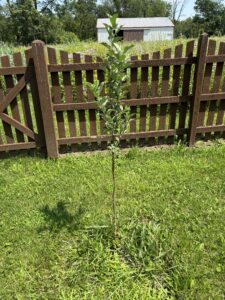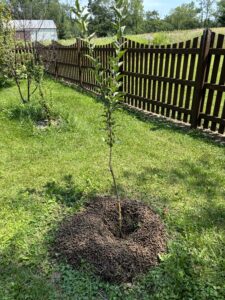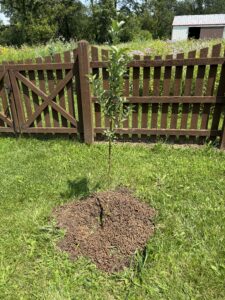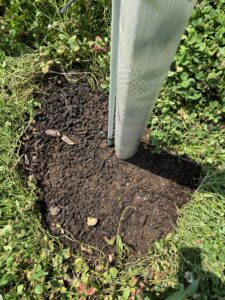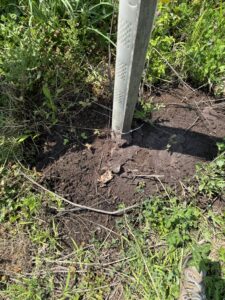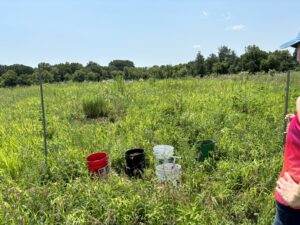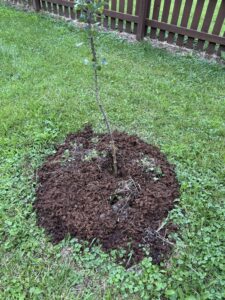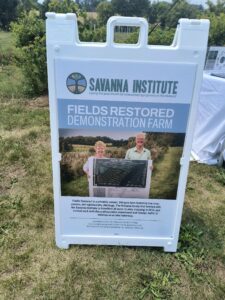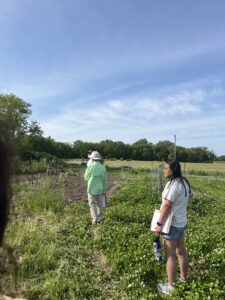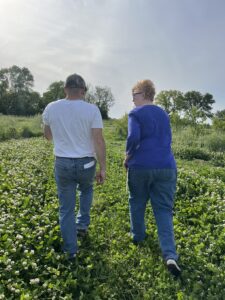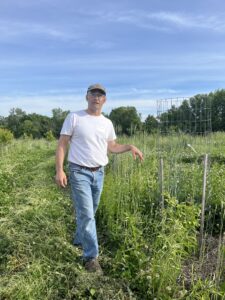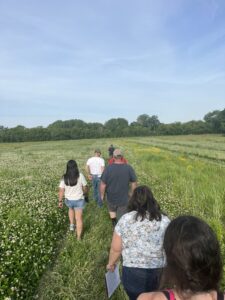Progress report for FNC24-1431
Project Information
Plescia- I am the eldest of 6 children. We were active in 4-H, bee keeping, and eating from a large garden. I completed a bachelors of science in biology from the University of IL in 2004. Soil health and local food production have always captivated me. Over the past 10 years I have been reading about agroforestry, going to field days, helping neighboring farmers, and watching webinars. Two years ago my family (wife Trisha and four children aged 11-16) and I purchased 20 acres of tillable land in Ogle County, IL that had been row crops for decades. We planted perennial cover crops and added hazelnuts, chestnuts, and fruit trees. Hazel Hill Orchard was born. One of those inspirational farm tours that I attended through the Savanna Institute was at Fields Restored, owned by Scott Williams. We often discuss ways to improve soil and the barriers to establishing more holistic farming practices in the upper Midwest. This collaboration coupled with my science background, strong work ethic, newly established orchard, and "home grown" work force, make me well suited to succeed with this project.
Williams- In 2015, my sister and I removed 17 acres from traditional corn/soybean rotation on our farm in northern IL and planted over 25,000 perennial woody food crop plants to demonstrate alley cropping and other agroforestry practices. We named this new operation Fields Restored.
The idea for this project was born from a visit to the University of Illinois to observe the fields planted by the Savanna Institute. The enthusiasm for conservation and sustainable agriculture came from our father, who was an early and active subscriber to such “novel” conservation practices as contour plowing and crop rotation. He built a dairy barn to deliberately acquire manure – a resource to improve soil composition, nutrient value, and tilth. Over time, that farm evolved from an unproductive eyesore of eroded gullies and depleted soil to a verdant showplace that university dairy science students visited on field trips. His conservation ethic rubbed off on us!
In 2018, I retired from my career as an association executive and merged into a new profession as a farmer. Weeding, mowing, maintaining and harvesting our asparagus, hazelnuts, blackberries, serviceberries, and rhubarb, and developing customer markets has become a rewarding and unexpected second career.
Today, I’m excited to develop and explore a new resource --- pelletized tree leaves as mulch and soil amendments.
Conventional annual row crops are leading to dangerous environmental consequences and do not always lead to healthy foods. Yearly tillage leads to wind and water erosion of the loosened soils. The mycorrhizal fungi, bacteria, and invertebrates that make soil healthy and vibrant get destroyed by tillage and subsequent dehydration and oxidation. Monocultures in the upper Midwest lead to habitat loss and species reduction, while excess nitrogen from fertilizers is contributing to a dead zone in the Gulf.
Agroforestry has the amazing potential to prevent and reverse some of these consequences, but it takes 5-15 years from planting to grow a marketable product in these perennial systems. It is arguably the most healthy farming technique for the environment and human consumption, but if the farmer cannot survive financially in these early years, then it is not viable. Alley cropping with annual cash crops between rows of trees/shrubs is another example of producing cash flow before nut/fruit trees are productive.
Can leaves be pelletized to use as a natural soil amendment and weed reducing mulch?
Can these pellets be used as an early revenue source for farmers who do not yet have marketable produce?
With this project we have positioned ourselves to explore these questions!
Photo Highlights from 2024: Pelletized Leaf mulch experiment
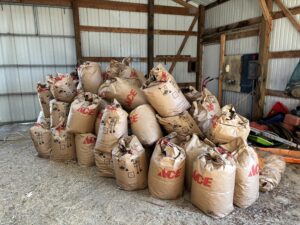
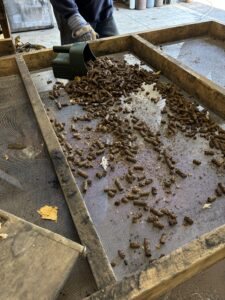
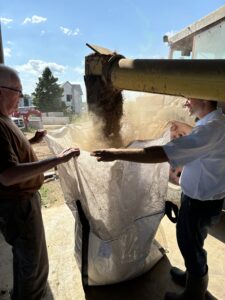
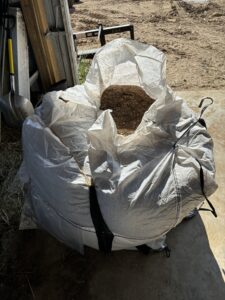
Cooperators
- - Producer
Research
Approximately 15 years ago Scott made a trial batch of pelletized leaves through the California Pellet Mill Company (CPM) in Waterloo, IA. This was a free service at the time, but now it has become costly to do trial studies. We have tested this sample through A & L Great Lakes Laboratories and found that it is a safe and inert product for soil improvement and weed suppression. Leaves are an excellent source of carbon, phosphorus, potassium, magnesium, and zinc. Leaves are a renewable resource that pile up on agroforestry farms and neighborhoods. In rural areas they blow around and slowly degrade wherever they settle. In urban neighborhoods they become a nuisance and are hauled away to storage/disposal areas. We are going to collect leaves from our farms and local municipalities in brown paper bags and recycle them into an all natural weed suppressant, moisture retainer, and soil booster!
A local town, Rochelle, IL allows us to bag leaves from their collection pile, or pick up the prebagged leaves. On our farms, this will entail mowing leaves into strips and then raking them into piles and collecting in brown paper bags. The bags will be stored in Scott's barn until we have a large load that can be taken to the pellet mill via a rented U- Haul.
The leaves can be ground and pressurized using CPM mills. This process leads to high temperatures, approximately 150 degrees, that denature weed seeds. The finished product consists of pellets approximately 1/2 inch in diameter x 1-2 inches in length that we can package in 20-40 pound bags.
This is a manageable size that individuals can then spread around the bases of fruit/nut trees, berries, vegetables, and flower beds. The leaf pellets can also be tilled into soil plots that are too sandy, clayish, or nutrient depleted. We will use the product on our own farms, and sell excess to local
home/garden stores, nurseries, landscapers, homeowners, and greenhouses.
Why can't people just use leaves for mulch? Why pelletize? Pelletizing condenses the product into a useful density, preventing them from blowing away and deteriorating too quickly. The pellets absorb moisture and hold it in the soil. The heating process destroys weed seeds along with some bacteria and fungi that can potentially infect plants. This prevents cross-contamination to the plants that we are applying the mulch to. We will test mixed batch, hazel, oak, maples, hybrid poplar, etc leaves and have the samples analyzed. We plan to take three batches of leaves to the pellet mill using a 26-foot rented U-Haul. We are going to test soil samples (pH, nitrogen, K, zinc, phosphorus, organic matter) from our farms before using our pelletized leaf product. We will test again one year later, after applying pellets.
In some ways this is an experimental process. We know the product can be made and we are quite confident that it will be useful as a mulch and weed suppressant. We want to be able to show that it improves the soil. If we can prove that this process is beneficial, then we can promote it to our neighbors. The economic benefit would be in sales of the product and improved production of agricultural crops. In the future, we might purchase a pellet mill and recycle local leaves independently (not having to transport them and pay CPM).
Organic matter is a vital component of healthy soils. We targeted tree leaves because they are abundant, free, and natural. The idea behind pelletizing the leaves as mulch is to make them more condensed and stable for use as mulch. The entire process is still in experimental stages. It requires some trial and error to get the pellets to a usable consistency. We do not own the equipment to process the leaves ourselves, so are relying on others for milling and pelletizing. Making the pellets is the difficult portion of this project. Using them is a joy! Many agroforesters, farmers, ranchers, and homeowners will appreciate this product. The pellets work as a soil amendment, weed barrier, and nutrient releasing mulch. We hope to prove that this process can be economical and beneficial in the realms mentioned above, so that other farmers and rangers can incorporate it into their projects.
2024 Project Summary:
On Monday 4/8/24 (eclipse day) Scott and I took our first load of leaves to Buskirk Engineering pellet mill in Indiana. We had planned to work with CPM but they had temporarily closed their operation in Iowa so we would have had to travel to OK. Then we found that Buskirk was going to be cheaper anyways so decided to go with them. A 20 foot U-Haul van was rented in Niles, IL and driven to Fields Restored in Oregon, IL. We loaded about 50 bags of leaves and drove them to the Buskirk mill.
The drive was enjoyable as we were able to stop to stretch our legs and view the solar eclipse. We saw a long line of vehicles coming from the "line of totality" as we got into Indiana. The pellet making process was slower than expected. It was very difficult to get the moisture content correct to form an acceptable pellet. If it was too dry, the pellets would not form and were extruded as leaf dust. If it was too wet, the mill bogged down. It became obvious, after several hours of trial and error, that the ideal pellet consistency (well-formed with a shiny durable outer shell) was elusive at this facility. Only about 10% of the pellets were adequate. If the texture of the pellets was too brittle (not shiny) they would not hold up in rains very well. This leads to more rapid breakdown of the product and less time as a weed barrier. We gathered the pellets made from the day's work into 5-gallon buckets and headed for home. It was clear that we needed a slightly different approach to make the process efficient and productive of a higher quality pellet. We made the 4+ hour drive home, disappointed and completely exhausted by days end.
Scott's prior experience making leaf pellets included a hammermilling step to shred the leaves before pelletizing. We had anticipated repeating this process at Buskirk, but learned upon arrival that their operation did not include a hammermill. Staff was hopeful that the hammermill process could be avoided, but we learned differently, confirming that hammermilling is a necessary step.
On 6/24/24 at 3pm we met with a Mennonite neighbor who has a hammermill and we processed approximately 30 lawn bags of dry leaves through his machine. The shredded leaf powder was collected from the auger into a large, white polyethene bag in the back of my truck. We paid him $300 for his assistance and use of the machine.
We stored the shredded leaves in my barn until 7/10/24 when we headed back to Indiana and the pellet mill, armed this time with hammermilled leaf dust. We decided to spend the night at a hotel and split the driving into two days. We stayed at Comfort Suites in Fort Wayne Indiana for $113.80. This was not in our budget, but was worthwhile, given the time needed at the mill, and 9-10 hour round trip commute. Having the leaves shredded before going into the pellet mill did help. However, finding the correct temperature and moisture content was still an issue, and through put was too slow to produce pellets in a volume that would be beneficial in the agroforestry context.
We drove home 7/11/24 with more 5-gallon buckets of leaf pellets with about a 20% quality, feeling a bit downtrodden but also hopeful that pelletized leaves can still be produced in an efficient/reliable manner. . . . somewhere else. We were learning each step of the journey.
During the summer of 2024 we used the Re-Leaf pellets on our own agroforestry plantings. We trialed them as mulch around young apple trees, flower beds, sugar maples, and heartnut trees. We took mental notes and some photos to document how it worked. We then took soil samples at 2 locations on each farm. Chestnuts and hazelnuts at Hazel Hill Orchard and rhubarb and along shed at Fields Restored. These samples were sent to A and L Great Lakes Laboratory in Indiana, and the results have been cataloged for future reference and comparison after Re-Leaf applications.
On approximately 8/7/24 we met with our neighbor and put the remainder of the leaves collected in autumn 2023 through his hammermill. We paid him another $300 for his services, and those shredded leaves are currently stored in my barn. Our plan is to take these to CPM for pelletizing in Iowa. Their facility has been under construction, but should be up an running again in early 2025. They are more expensive but are known to produce a leaf pellet that meets our needs. Unfortunately, the pellet mill we had identified for initial production (CPM) closed for major reconstruction. We’ve been therefore detained for a year until they are back online and fully operational. This will require extending our project until 2027.
From October-December 2024 we collected leaves for our next round of production. This was accomplished by us as well as hired local teenagers. Bagged leaves are collected with personal vans/trucks and stored in dry barns.
Educational & Outreach Activities
Participation Summary:
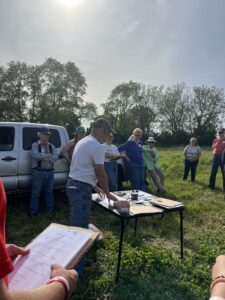
We belong to a loose organization called NILSAG (Northern IL Sustainable Agriculture Group). I advertised to this group via email and word of mouth. We had approximately 30 participants at a Hazel Hill Orchard field day on 5/24/25. 10/30 were children, 20/30 were local sustainable agriculture enthusiasts. It was a sunny, warm, breezy day and the participants were enthusiastic. We demonstrated the agroforestry practices and explained the uses and benefits of Re-Leaf pellets. A survey was given and the 20 adult participants completed the survey (results below). Excellent discussion and information was shared and the event was completed with a BBQ sourced with local grass fed beef, asparagus, and samples of hazelnuts.
On 6/22/24 a field day was held at Fields Restored focused on juneberry cultivars. Savanna Institute representatives were present as well as friends and neighbors from local and suburban communities. Our plan had been to introduce leaf pellets during this event, but our production season didn't yield a quality or quantity sufficient to demonstrate. We hope to address this at future field days.
Survey Results:
SARE Grant Survey 5/24/24
- Do you use mulch or woodchips at your home, farm, or property? Yes/No
20/0
- Before today, have you heard of using pelletized leaves as a weed suppressant or soil amendment? Yes/No
8/12
- Does this type of product appeal to you? Yes/No
18/2
- Would you be interested in using pelletized leaves for mulch or soil amendment on your property? Yes/No
18/2 One unsure, 1 already has plenty of wood chips
- Do you think you would enjoy using this product? Yes/No
18/2
- If yes, how might you use this product?
_17/20____ Mulch
___12/20__ Soil Amendment ___16/20__ Weed Control
